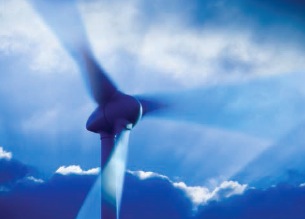By Mick Sagrillo November 18, 2008

The power produced depends on the mass of air moving through the rotor disc. Large rotors make more power. Photo: Istockphoto.com
One of the biggest hurdles that anyone interested in installing a small wind turbine faces is securing a building permit. Zoning committees are notoriously uninformed about why wind turbine towers need to be as high as they are, but are very tuned in to neighbor concerns about the visibility of such structures. All too often, a wind turbine tower is restricted to a height limit either because a height limit is “on the books” or to appease the neighbors at the expense of the prospective small wind owner. In the next few issues of SOLAR TODAY, we will explore why small wind systems are mounted on tall towers, as well as offer suggestions for zoning authorities in dealing with such installation requests.
Small wind is defined as up to and including 100 kilowatts in capacity. This upper limit is a fairly large “small” wind turbine, capable of powering a farm, business, small school district or environmental center. But “small wind” also includes residential wind equipment and cabin-sized off-grid battery charging equipment, considerably under the 100-kW cap.

The power produced by a wind turbine is determined by the size of the rotor.
The kilowatt rating of a small wind turbine doesn’t really tell you how much energy the machine will produce over any period of time. It only tells you the maximum sustained capacity of the generator. Far more important than the generator size is the swept area of the rotor. The swept area is the circle through which the rotor blades spin as they collect the energy in the wind. Output is a function of the size of the collector, not the size of the generator. Just as with solar water-heating or photo- voltaic systems, the larger the collector, the more energy you can extract from your fuel source. In our case the fuel is the wind. The larger the swept area of the rotor, the more electricity we generate. To quote author Paul Gipe, “Nothing says more about the output of a wind turbine than the size of its rotor.”
The smallest of small wind turbines have blades that may be only 4 feet (1.2 meters) long (we exclude micro-turbines for portable use). However, at the upper end of the small-wind range, 100 kW, blades can measure 35 feet (10.5 meters) long, for a 70-foot (21-meter) diameter.

The wind power available to a turbine rises as the turbine is moved away from ground friction and into stronger wind aloft.
The reason that tall towers are required for wind turbines is to allow them to reach their fuel source, the wind. Even though you may feel some wind at ground level, the reality is that the resource at ground level is greatly diminished and compromised. Wind is a fluid, and as it passes over a solid earth, friction occurs between the two. Meteorologists call this “ground drag.” The result of ground drag is to slow the moving air masses near the ground level, with increasing wind velocity as you move away from the surface of the earth. Since we want higher wind speeds to “fuel” our wind turbine, it only makes sense to go up high where the wind is strong, not near the ground where it is greatly reduced. Simply put, the higher you go above the surface of the earth, the stronger, smoother and more reliable the wind. The higher the quantity of fuel, the more electricity you can generate.
Most zoning officials don’t know that the common 35-foot height limit is a relic of old fire-safety codes. In the 19th century, large corporations hired millions of recent immigrants to work in factories. They often crowded workers into squalid and dangerous buildings, with results like the 146 deaths in New York’s Triangle Shirtwaist fire of 1911. Similar disasters prompted passage of new building, plumbing and fire codes. In an era before firefighters had portable high-pressure pumps, they could only pump water about 35 feet vertically. Codes were written to ensure that a fire department could douse a roof. Today’s fire-fighting technology easily overcomes this problem, but in most jurisdictions we are still saddled with this arcane height regulation.
Next issue we will lay out the rules of thumb used to size wind turbine tower height.
Mick Sagrillo, a small wind consultant, owns Sagrillo Power & Light and is the wind energy specialist for Focus on Energy, Wisconsin’s renewable energy program. Research for this article was funded in part through Wisconsin’s Focus on Energy Program. Contact him at msagrillo@wizunwired.net




